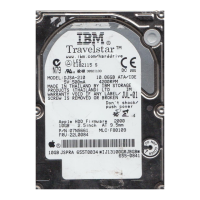With Global Mirror, the data that the host writes to the storage unit at the local site
is asynchronously shadowed to the storage unit at the remote site. A consistent
copy of the data is then automatically maintained on the storage unit at the remote
site.
Use of Global Mirror does not guarantee against data loss. During a disaster, data
can only be restored to the last known consistent increment that was created. This
means that data that is written to the primary site and is waiting to be transferred to
the secondary site is lost whenever the two storage units can no longer
communicate.
The following considerations apply when you use the Global Mirror recovery
process:
v The Global Mirror master might still be running at the local site, especially if the
disaster at the local site is a rolling disaster in which not all components fail
simultaneously.
v The consistent copy at the remote site is not the secondary volume, but it is the
FlashCopy target whose source is the secondary volume.
v Formation of a consistency group might have been in progress at the time of the
failure.
v You can speed up recovery processing by choosing the Fast Reverse restore
process that is explained later in this section.
Perform
the following steps to use Global Mirror for an unplanned failover using the
DS Storage Manager. You can also use the DS CLI for these steps.
Note: For details on individuals tasks, see the related topics section.
1. Enter the Global Mirror session at the local site.
Note: Wait until the master storage unit completes the termination processing
or enters the fatal state before continuing with the next step. Of course,
this might not be possible if the local site has completely failed. If that is
the case, proceed to the next step without waiting.
2. Issue a recovery failover request on the Global Copy volumes pair to force a
stop of the Volume A to Volume B extended distance relationship and create a
Volume B to Volume A Global Copy relationship.
Note: All B volumes must successfully process the recovery failover request
before you can move to the next step.
3. Look at the session properties for Volume B and Volume C to ascertain the
state of the consistency group between the B volume and C volume. You are
looking primarily at the FlashCopy relationships and your analysis determines
your next step in the recovery process. Act on your analysis as follows:
a. FlashCopy relationships are nonrestorable and all the sequence numbers
are equal. No action to the consistency group is necessary.
b. FlashCopy relationships are restorable and all the sequence numbers are
equal. Issue the FlashCopy Discard changes command to all the
FlashCopy relationships in the consistency group.
c. All the FlashCopy sequence numbers are equal and at least one of the
FlashCopy relationships is nonrestorable. Issue a FlashCopy Commit
changes command to all the FlashCopy relationships in the consistency
group that are restorable.
150 DS8000 User’s Guide

